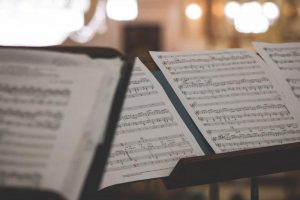As children, we learn to identify letters followed by simple words. We then gradually progress to reading a full sentence. The next step is learning how to read multiple clauses. Eventually, this turns into reading complex paragraphs, whole chapters, and more. We learn musical notation in similar stages, and our musical literacy becomes defined by our understanding of music theory. Like any language, it’s not enough to just read the words and symbols on the page. You have to understand what it all means.
So Where Do We Start?
For beginners, the main subject areas of music theory are:
- Timing and Rhythm
- Melody and Harmony (pitch relationships)
- Dynamics (loud vs. soft)
Let’s go through them one at a time. Bare in mind, this blog does not include illustrations a teacher might provide. So make sure you review all of this material carefully with your instructor.
1. Timing and Rhythm
Beginners must learn how to follow a strict, unwavering pulse in music. 4/4 is the most common time signature or meter. There are many other meters too. In 4/4 time, the quarter note receives or equals one beat, and there are four beats per measure. In 3/4 time, another common time signature, there are 3 beats per measure, but the quarter note still equals one beat.
But what is a beat, and what is a measure?
A beat is a unit of time. It is the pulse of the music. If you see someone tapping their foot to a song, they are probably tapping to the beat. A measure or bar is a segment of music, and bar lines indicate the beginning and the end of each measure. All music is segmented into measures, and unless the time signature changes, those measures must all have the same number of beats.
To understand basic rhythms, you must understand simple math. Beginners will need to understand whole, half, quarter, and eighth notes. These are not the only rhythms in music, but these are the ones used most often by beginners.
Imagine a whole pie or a full circle. Let’s call that pie a whole note. If you divide the whole note into equal halves, you now have two half notes. If you divide it into equal quarters, you now have four quarter notes. Divide it again into eight equal parts and you now have eight eighth notes.
All of these rhythms add up to one whole note. This is best illustrated by a rhythm tree, which shows the divisional relationship between notes. The same relationships exist between musical rests (silent notes). For each note, there is an equivalent rest.
2. Melody and Harmony (pitch relationships)
There are seven pitches in music: A, B, C, D, E, F, and G, plus corresponding flats and sharps. To begin to understand pitch relationships you must grasp:
- Diatonic Intervals
- Scales (also called modes)
But first, what is a melody?
Melodies are single musical lines (sung or played) that usually hover above the chords (harmony). The melody captures the attention of the ear, and it may be referred to as the “tune” of a piece. Melody and harmony are always related. They use the same ingredients and both exist in the same key. A key is a set of notes that corresponds to a specific major or minor scale. There are 15 major keys, and the relationship between these keys (and scales) is best understood through a diagram called The Circle of Fifths.
Let’s dissect an ascending C major scale to understand its elements. Like all scales, the major scale is composed of diatonic intervals. On the piano, C major uses the white keys of the keyboard. There are seven distinct notes in a C major scale: C, D, E, F, G, A, B followed by a return to the pitch C. However, since you are ascending the keyboard, the second C is played one octave higher than the first C.
The intervallic relationship between these notes is:
- Whole Step (C to D)
- Whole Step (D to E)
- Half Step (E to F)
- Whole Step (F to G)
- A Whole Step (G to A)
- Another Whole Step (A to B)
- Half Step (B to C)
An intervallic step is the distance between two notes. Steps may be whole or half. You will notice that there are seven steps–also called scale degrees–in the C major scale. This is true of all major and minor scales. In the major scale, there are five whole steps and two half steps. Melodic intervals are played consecutively. Harmonic intervals are played together.
Chords (harmony) are formed by combining two or more notes. If you play the notes of a chord simultaneously, they are called block chords. If you play the chord tones in succession, they are called broken chords. Basic chords, such as C major, often contain three notes (triad). In this example, the notes are: C, E, and G. More advanced chords contain chordal extensions or additional notes, which add sophistication to the sound of the chord.
3. Dynamics (loud vs. soft)
Music that is mono-dynamic (one volume) sounds flat and uninteresting. Dynamics allow the performer to play multidimensionally and with greater expression. The most important dynamic levels a student needs to know are: pp (pianissimo or very soft), p (piano or soft), mp (mezzo-piano or medium soft), mf (mezzo-forte or medium loud), f (forte or loud), and ff (fortissimo or very loud).
Dynamics are relative to the piece of music, and to other external factors like the acoustics of the performance venue and, when applicable, the size and makeup of an ensemble. Genre and era may play a factor as well.
Put Your Music Theory Basics into Practice
I hope you’ll explore each of the terms used in this blog to continue your study of music theory. When you’re playing a piece on the piano, or reading sheet music in your next guitar lessons – use these music theory basics to help you deepen your understanding of the musical language.
Eric Starr


